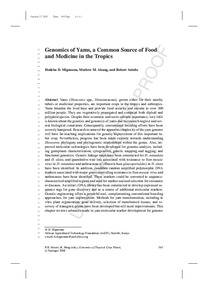| dc.contributor.author | Mignouna, H.D. |
| dc.contributor.author | Abang, Mathew M. |
| dc.contributor.author | Asiedu, Robert |
| dc.date.accessioned | 2019-12-04T11:20:53Z |
| dc.date.available | 2019-12-04T11:20:53Z |
| dc.date.issued | 2008 |
| dc.identifier.citation | Mignouna, H.D., Abang, M.M. & Asiedu, R. (2008). Genomics of yams, a common source of food and medicine in the tropics. In P.H. Moore and R. Ming, Genomics of tropical crop plants (p. 549-570). New York: Springer. |
| dc.identifier.uri | https://hdl.handle.net/20.500.12478/3568 |
| dc.description.abstract | Yams (Dioscorea spp., Dioscoreaceae), grown either for their starchy tubers or medicinal properties, are important crops in the tropics and subtropics. Yams broaden the food base and provide food security and income to over 300 million people. They are vegetatively propagated and comprise both diploid and polyploid species. Despite their economic and socio-cultural importance, very little is known about the genetics and genomics of yams due to research neglect and several biological constraints. Consequently, conventional breeding efforts have been severely hampered. Research to unravel the apparent complexity of the yam genome will have far-reaching implications for genetic improvement of this important tuber crop. Nevertheless, progress has been made recently towards understanding Dioscorea phylogeny and phylogenetic relationships within the genus. Also, improved molecular technologies have been developed for genome analysis, including germplasm characterization, cytogenetics, genetic mapping and tagging, and functional genomics. Genetic linkage maps have been constructed for D. rotundata and D. alata, and quantitative trait loci associated with resistance to Yam mosaic virus in D. rotundata and anthracnose (Colletotrichum gloeosporioides) in D. alata have been identified. In addition, candidate random amplified polymorphic DNA markers associated with major genes controlling resistance to Yam mosaic virus and anthracnose have been identified. These markers could be converted to sequencecharacterized amplified regions and used formarker-assisted selection for resistance to diseases. An initial cDNA library has been constructed to develop expressed sequence tags for gene discovery and as a source of additional molecular markers. Genetic engineering offers a powerful tool, complementing conventional breeding approaches, for yam improvement. Methods for yam transformation, including in vitro plant regeneration, gene delivery, selection of transformed tissues, and recovery of transgenic plants have been developed but still need improvements. This chapter reviews advances made in yam molecular marker development for genome analysis, phylogeny, molecular cytogenetics, characterization of genetic diversity, genetic mapping and tagging, and progress in functional genomics. |
| dc.description.sponsorship | Gatsby Charitable Foundation |
| dc.language.iso | en |
| dc.subject | Yams |
| dc.subject | Tropics |
| dc.subject | Genomics Of Yams |
| dc.subject | Dioscorea Spp. |
| dc.subject | Breeding |
| dc.title | Genomics of yams, a common source of food and medicine in the tropics |
| dc.type | Book Chapter |
| dc.description.version | Peer Review |
| cg.contributor.affiliation | African Agricultural Technology Foundation |
| cg.contributor.affiliation | International Center for Tropical Agriculture |
| cg.contributor.affiliation | International Institute of Tropical Agriculture |
| cg.coverage.region | Africa |
| cg.coverage.region | Acp |
| cg.coverage.region | West Africa |
| cg.coverage.region | North America |
| cg.coverage.country | Nigeria |
| cg.coverage.country | Benin |
| cg.coverage.country | Canada |
| cg.authorship.types | CGIAR and developing country institute |
| cg.iitasubject | Yam |
| cg.iitasubject | Plant Breeding |
| cg.iitasubject | Genetic Improvement |
| cg.iitasubject | Soil Surveys And Mapping |
| cg.accessibilitystatus | Limited Access |
| local.dspaceid | 95540 |

